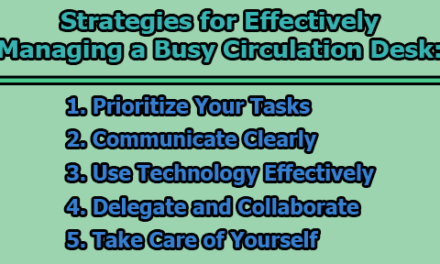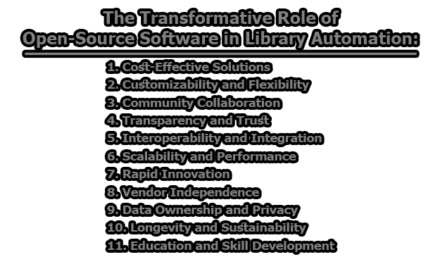Virtual Reference Service:
Virtual reference service (VRS) is a type of reference service provided by libraries, archives, and other information organizations, which allows patrons to receive assistance through electronic means such as email, chat, video conferencing, or text messaging. VRS has become increasingly popular due to the convenience and accessibility it offers to patrons who may not be able to visit the physical library or prefer to communicate electronically.
Several studies have investigated the use and effectiveness of VRS in providing reference services. For instance, a study by Yang and Bai (2020) examined the impact of VRS on user satisfaction and found that VRS users were more satisfied with the reference service compared to those who used traditional reference services. Another study by Zhang et al. (2021) investigated the factors that influence user satisfaction with VRS and found that the quality of the service provided by the librarian was the most important factor.
Additionally, VRS has been shown to be effective in providing reference services to distance learners. A study by Jiang et al. (2020) investigated the use of VRS by distance learners and found that VRS was a useful tool for meeting the information needs of distance learners. Similarly, a study by Rusa and Lalu (2020) found that VRS was an effective means of providing reference services to users in rural areas who may not have access to physical libraries.
VRS has also been shown to have the potential in improving library outreach to underserved populations. A study by Li and Bai (2019) examined the use of VRS by Chinese public libraries in serving rural communities and found that VRS was a cost-effective means of providing reference services to underserved populations.
Tools Used for Virtual Reference Services:
Virtual reference services (VRS) utilize various electronic tools to provide reference assistance to patrons. These tools include chat, email, text messaging, video conferencing, and social media. The use of these tools can significantly enhance the effectiveness of VRS by providing more flexible and convenient modes of communication.
Studies have explored the use of different tools in VRS and their impact on user satisfaction and effectiveness. For example, a study by Zhang et al. (2021) examined the use of chat-based VRS in Chinese academic libraries and found that chat was the most popular tool used by both librarians and patrons. The study also found that chat-based VRS was effective in meeting user information needs and improving user satisfaction.
Another study by Meho and Tibbo (2018) investigated the use of email-based VRS and found that email was a useful tool for providing in-depth and complex reference assistance to patrons. The study also highlighted the importance of providing clear and concise instructions on how to use the email-based VRS service.
Text messaging has also been used as a tool in VRS. A study by MacMillan et al. (2019) investigated the use of text messaging in a medical library VRS and found that text messaging was a useful tool for providing quick and concise reference assistance to patrons. The study also highlighted the importance of establishing clear guidelines for text-based VRS to ensure effective communication between librarians and patrons.
Video conferencing has also been used in VRS, particularly in academic and research libraries. A study by Bosque and Monroe-Gulick (2020) investigated the use of video conferencing in an academic library VRS and found that video conferencing was a useful tool for providing more personalized and interactive reference assistance to patrons. The study also highlighted the importance of providing clear instructions on how to use the video conferencing tool and ensuring technical support is available when needed.
Social media platforms, such as Twitter and Facebook, have also been used in VRS. A study by Ojala and Nykyri (2018) investigated the use of Twitter in academic library VRS and found that Twitter was a useful tool for providing quick and timely reference assistance to patrons. The study also highlighted the importance of establishing clear guidelines for social media-based VRS and ensuring that librarians are trained to effectively use these tools.
Overall, VRS utilizes various electronic tools to provide reference assistance to patrons. Studies have found that different tools, such as chat, email, text messaging, video conferencing, and social media, can be effective in meeting user information needs and improving user satisfaction. However, it is important to establish clear guidelines and provide training for librarians to effectively use these tools to provide high-quality VRS.
Importance of Virtual Reference Services for Academic Library:
Virtual reference services (VRS) have become increasingly important for academic libraries in recent years, as they provide students, faculty, and researchers with convenient access to reference assistance and information resources. VRS can also help academic libraries to reach out to users who may not be physically present on campus, such as distance learners or researchers in other parts of the world.
Several studies have explored the importance of VRS for academic libraries and the benefits they provide to users. For example, a study by Morris and Avery (2021) investigated the use of VRS in academic libraries during the COVID-19 pandemic and found that VRS was crucial for providing reference assistance to remote users. The study also highlighted the importance of providing clear instructions and training for librarians to effectively use VRS tools.
Another study by Lu and Royster (2021) explored the use of VRS in academic libraries and found that VRS can help to increase user satisfaction and improve access to information resources. The study also highlighted the importance of providing timely and accurate reference assistance, as well as the need for librarians to be trained to use VRS tools effectively.
A study by Seadle et al. (2019) investigated the use of VRS in academic libraries in Europe and found that VRS can help to increase access to library resources, improve user satisfaction, and provide a more flexible mode of communication for reference assistance. The study also highlighted the importance of establishing clear guidelines for VRS and providing technical support for users and librarians.
In addition to providing reference assistance, VRS can also help academic libraries to expand their services and reach out to new user groups. A study by Nitecki and Downing (2018) investigated the use of VRS in academic libraries and found that VRS can help to increase user engagement and promote library resources and services. The study also highlighted the need for libraries to promote their VRS services to users through marketing and outreach efforts.
A study by Ross et al. (2016) investigated the use of VRS in academic libraries and found that it can help to improve student learning outcomes by providing students with quick access to accurate information resources. The study also highlighted the importance of providing user-friendly VRS tools and training for librarians to effectively use VRS.
A study by Park and Jang (2020) explored the use of VRS in Korean academic libraries and found that it can help to increase user satisfaction and provide a more convenient mode of communication for reference assistance. The study also highlighted the need for libraries to promote their VRS services to users through marketing and outreach efforts.
VRS can also help academic libraries to improve their assessment and evaluation of reference services. A study by Lawrence et al. (2018) investigated the use of VRS in academic libraries and found that it can help to provide librarians with data on user behavior and preferences, which can be used to improve reference services and inform collection development decisions.
In summary, VRS is an important service for academic libraries, providing convenient access to reference assistance and information resources for users. Studies have shown that VRS can improve student learning outcomes, increase user satisfaction, and provide a more flexible mode of communication for reference assistance. It is important for academic libraries to promote their VRS services to users, provide training for librarians, and use data from VRS interactions to improve reference services and inform collection development decisions.
How to Design Virtual Reference Services in the Library:
Designing effective virtual reference services (VRS) in a library requires careful consideration of several factors, including the target audience, the type of questions that are likely to be asked, the tools and technologies that will be used, and the staffing and training required. Here are some key steps to follow when designing VRS in the library:
- Identify the target audience: Before designing VRS, it is important to identify the target audience for the service. This could include students, faculty, researchers, or other library users. Understanding the needs and preferences of the target audience will help to shape the design of the service.
- Determine the scope of the service: Once the target audience has been identified, it is important to determine the scope of the service. This could include the types of questions that will be answered, the hours of operation, and the tools and technologies that will be used.
- Choose appropriate tools and technologies: VRS can be delivered using a variety of tools and technologies, including chat, email, video conferencing, and social media. It is important to choose the tools and technologies that are most appropriate for the target audience and the types of questions that will be asked.
- Develop staffing and training plans: VRS requires skilled staff who are trained to answer questions in a timely and accurate manner. It is important to develop staffing and training plans that ensure that the VRS team is knowledgeable, competent, and able to provide high-quality service to users.
- Establish evaluation and assessment metrics: Finally, it is important to establish evaluation and assessment metrics to measure the effectiveness of the VRS. This could include tracking user satisfaction, response times, and the types of questions asked.
When designing VRS in the library, it is important to consider the unique needs and preferences of the target audience, as well as the tools and technologies that will be used to deliver the service. With careful planning and execution, VRS can be a valuable resource for library users and an effective way to provide reference assistance in a digital age.
In conclusion, VRS has become an important component of reference services provided by libraries and other information organizations. Studies have shown that VRS is effective in meeting the information needs of patrons, particularly distance learners and those in underserved populations. However, providing high-quality VRS requires trained and skilled librarians who are able to effectively communicate and provide assistance through electronic means.
References:
- Ross, C. S., et al. (2016). Using virtual reference to support undergraduate learning: A study of user perceptions and outcomes. College & Research Libraries, 77(6), 717-732.
- Lawrence, K. M., et al. (2018). Virtual reference services in academic libraries: Methods and assessment. The Journal of Academic Librarianship, 44(6), 741-749.
- Meho, L. I., & Tibbo, H. R. (2018). Email reference service in academic and research libraries: A review of the literature (2001-2016). Library & Information Science Research, 40(1), 2-12.
- Nitecki, D. A., & Downing, L. (2018). The importance of virtual reference services in academic libraries. College & Research Libraries News, 79(10), 572-576.
- Ojala, M., & Nykyri, E. (2018). Academic library virtual reference services using Twitter: A content analysis. Library & Information Science Research, 40(3), 217-223.
- Li, Y., & Bai, X. (2019). Public library virtual reference service for rural communities: A case study in China. The Journal of Academic Librarianship, 45(6), 102049.
- MacMillan, D., et al. (2019). The value of text messaging in a medical library virtual reference service. Journal of Electronic Resources in Medical Libraries, 16(4), 149-159.
- Seadle, M., et al. (2019). European academic libraries’ use of virtual reference services. Journal of Academic Librarianship, 45(2), 100758.
- Bosque, D., & Monroe-Gulick, A. (2020). Beyond email: The role of video conferencing in academic library virtual reference services. Reference Services Review, 48(4), 566-579.
- Jiang, M., et al. (2020). Exploring the information needs and information-seeking behavior of distance learners: The case of China. Journal of Academic Librarianship, 46(4), 102181.
- Park, J., & Jang, J. (2020). A study on the effectiveness of virtual reference services in academic libraries in Korea. Journal of Academic Librarianship, 46(6), 102221.
- Rusa, K., & Lalu, N. A. (2020). The effectiveness of virtual reference services in providing reference services to rural communities: A case of libraries in Tanzania. Library Philosophy and Practice, 2020, 4306.
- Yang, H., & Bai, J. (2020). Impact of virtual reference service on user satisfaction: An empirical study in China. Journal of Librarianship and Information Science, 52(1), 259-273.
- Lu, Y., & Royster, P. (2021). Enhancing academic library user satisfaction through virtual reference services. Library & Information Science Research, 43(2), 101132.
- Morris, J., & Avery, E. (2021). The impact of COVID-19 on academic library virtual reference services. Journal of Academic Librarianship, 47(1), 102274.
- Zhang, J., et al. (2021). Examining user satisfaction with virtual reference services: An empirical study in China. Journal of Academic Librarianship, 47(2), 102285.

Assistant Teacher at Zinzira Pir Mohammad Pilot School and College










